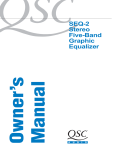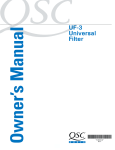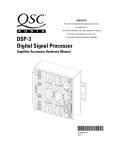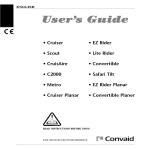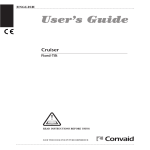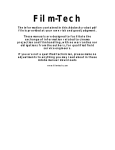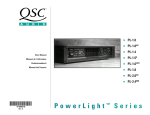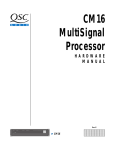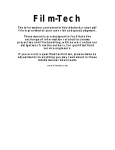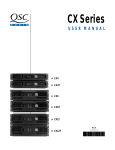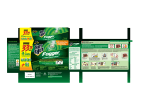Download QSC SEQ-2 Owner`s manual
Transcript
Owner’s Manual SEQ-2 Stereo Five-Band Graphic Equalizer *TD-000308-TS* 9 *TD-000308-TS* Rev. B *TD-004031-00* Rev. A SEQ -2 STEREO FIVE-B AND GR APHIC EQU ALIZER SEQ-2 FIVE-BAND GRAPHIC EQUALIZER I. DESCRIPTION The SEQ-2 is an embedded stereo (dual-channel) five-band graphic equalizer accessory for use with select QSC power amplifiers. Compatible amplifier models and lines, both current and discontinued, include: • All PLX (original series), two-channel CX, and two-channel DCA models (with a BSC-3 or BSC-5 BusCard installed) • All four-channel CX and DCA models (with a BSC-7 BusCard installed) • PowerLight models PL 1.0, PL 1.0HV, PL 1.4, PL 1.5X, PL 1.6HVX, PL 1.8, and PL 2.0HV (with a BSC-2* or BSC-4 BusCard installed) • PowerLight models PL 3.4, PL 3.8X, and PL 4.0 (with a BSC-6 BusCard* installed) • All MXa models (MX 1000a, MX 1500a, MX 2000a, and MX 3000a; Note: does not include MX 700), which use Level 1 Open Input Architecture • All EX models (EX 800, EX 1250, EX 2500, and EX 4000), which use Level 2 Open Input Architecture • Legacy CX models CX6, CX6T, CX12, and CX12T, which use Level 1 Open Input Architecture * When the SEQ-2 and BusCard are installed in an amplifier, access to some or all of the SEQ-2’s trimpots is restricted. Using the SEQ-2 as a default EQ is ideal for rental sound systems, since it virtually eliminates the possibility of unauthorized tampering with settings or other such user errors. Physically, the SEQ-2 is a small circuit card that mounts inside the amplifier. EX, MXa, and legacy CX amplifier models that use Open Input Architecture have a two-section row of 22 solder holes called a “Mini Slot” on their input boards. This is where the SEQ-2 is installed. The input board is part of the removeable input module, so the SEQ-2 can be installed without opening the amplifier chassis or even removing the amplifier from its equipment rack. Other models such as the PowerLight, PLX, DCA and CX series require the installation of an appropriate BusCard in order to provide a slot for the SEQ-2. Depending on the amplifier model, a BusCard can provide as many as four slots for accessory cards. Each slot is equivalent to the “Mini Slot” of the older amplifiers’ Open Input Architecture. For ease of installation, it is best to mount the SEQ-2 to the BusCard before installing the BusCard itself inside the amplifier. NOTE: The PLX2, PowerLight 2, and PowerLight 3 series amplifiers are not compatible with BusCards. The installation process involves soldering, so only qualified technical persons should attempt to install the SEQ-2; ideally, you should enlist QSC’s Technical Services department or an Figure 1. Boost and cut response curves of the SEQ-2 authorized service center to perform the task. The installation section of this manual offers more information about installing the SEQ-2. II. FEA TURES FEATURES Both channels feature electronically balanced input circuitry and five bands of fixed-frequency boost/cut filtering. Figure 1 shows the audio spectral characteristics of the filtering circuits. Either channel can be bypassed or engaged by placement of a jumper on the SEQ-2 card. The SEQ-2’s standard filter section frequencies are set in two-octave intervals: 40 Hz, 160 Hz, 630 Hz, 2.5 kHz, and 10 kHz; however, the equalizers can be constructed with custom frequencies. The standard Q (center frequency ÷ bandwidth at ±3 dB points) of each filter section is 0.75, but that figure can also be customized. Copyright © 2000, 2003, 2010 QSC Audio Products, LLC. All rights reserved. 1 III. PR OGR AMMING THE SEQ -2 PROGR OGRAMMING SEQ-2 The SEQ-2 circuit board has two 3-pin headers, and two groups of five trimmer potentiometers, or trimpots (see Figure 2); all are used for programming the module. The circuitry for the two channels is identical. Depending on its position on some BusCards, the SEQ-2’s bypass/engage jumpers and headers may not be easily accessible once the accessory is installed; on such units, configure the jumpers before installing the accessory on the BusCard. However, the trimpots, which control the amount of boost or cut on each band, can be fully adjusted after installation. Notes on Stereo, Bridged, or Parallel Operation The input board or amplifier into which the SEQ-2 is installed typically has a switch for setting the operating mode of the amplifier—i.e., stereo, parallel mono, or bridged mono. In the signal flow, the Mini Slot or BusCard is located somewhere after this switch, so you must configure the channels of the 1 SEQ-2 according to the oper2 ating mode selected. In ste3 Place jumper across pins 1 and 2 to bypass Place jumper across pins 1 and 2 to bypass Place jumper across pins 2 and 3 to engage Place jumper across pins 2 and 3 to engage reo or parallel mode, you J2 J3 must configure or bypass both Channel 1 engage/bypass Channel 2 engage/bypass channels. If the amplifier is in bridged mode, bypass channel 2 and use channel 1’s input and processing only. Bypassing the filtering To completely bypass a channel’s filtering circuitry, Figure 2. Engage/bypass headers on the SEQ-2 set the jumper on its header across pins 1 and 2, which are the upper two pins (see Figure 2). Note: If you neglect to place a jumper on a header, no signal will pass on that channel. Programming the equalizer To use the equalizer on a channel of the SEQ-2, set the jumper across pins 2 and 3 on that channel’s header. Figure 3 shows the trimpots and the frequencies they control. Figure 4 shows the effect of a trimpot on boost and cut. Channel 2 10 kHz 2.5 kHz 630 Hz Channel 1 160 Hz 40 Hz 10 kHz 2.5 kHz 630 Hz 160 Hz 40 Hz Figure 3. The SEQ-2’s ten trimpots, by channel and frequency band -4 +7 -12 dB -2 0 +2 +4 +7 +12 dB Figure 4. Details of trimpot adjustment IV ALL ATION IV.. INST INSTALL ALLA Installating the SEQ-2 requires PC board soldering skills, so only qualified service technicians should attempt it. Any authorized QSC service center—or, for an additional installation fee, the QSC Technical Services department—can perform the installation. When installed, the SEQ-2 settings and adjustments are not externally adjustable; this can prevent tampering by unauthorized users. 2 Installing the SEQ-2 Tools and materials you will need: • Soldering iron • Desoldering iron or other suitable desoldering equipment • Phillips screwdriver • Wire cutters • Rosin-core electronic solder • Non-conductive alignment tool (slot type), for adjusting trimpots The SEQ-2 contains active components which can be damaged by electrostatic discharge (ESD). Be sure to practice standard ESD precautions and always ground yourself and your workstation before handling exposed circuit cards. EX, MXa, or legacy CX models The SEQ-2 installs on the input PC board of a QSC EX, MXa, or legacy CX (except the CX4 and CX4T) Series amplifier. Some older EX or MXa amplifiers may require an upgrade to replace the original input board; for these amplifiers, contact the QSC Technical Services department for details on compatibility. Preparing the input board (MXa, EX, and legacy CX models only) If installing in a PowerLight, PLX, DCA, or current CX amplifier, skip ahead to the BusCard preparation procedure. LOW IMPEDANCE CH1 DIR. OUTPUT Input card BRIDGE MONO CH2 12 10 8 6 4 2 14 18 24 GROUND STEREO 14 18 24 -dB 0 LEVEL INPUT CH1 12 10 8 CH2 INPUT CH1 PARALLEL BRIDGE LOW IMPEDANCE CH2 DIR. OUTPUT 6 4 2 CH1 AUDIO TRANSFORMER 0 70 100 ISOL.OUTPUT 70V 25V 100V CH2 AUDIO TRANSFORMER 0 70 100 ISOL.OUTPUT -dB 0 LEVEL BRIDGE MONO 70V 25V 100V Figure 5. Location of the input card (legacy CX model shown). MXa and EX amplifiers are similar. Do not use desoldering braid, because it may damage the solder pads on the input board or BusCard, and it also might not adequately remove solder. CAUTION: On MXa, EX, and legacy CX amplifiers, preparing the input board for installation of the SEQ-2 involves removing solder from feed-through holes on a two-sided circuit card. Excessive heat can easily damage the solder pads you will be working on. Proper equipment and experience with desoldering delicate PC board circuitry is essential to successfully perform the following procedure. Please contact the QSC Technical Services department if you feel you might not be qualified to perform the installation yourself. One last warning: damage caused by an improper installation will void the warranty. 1. Before you start any work, turn off the amplifier power switch and disconnect the AC power cord from the AC source. Disconnect all cables from the amplifier’s input panel. 2. Position the amplifier so the rear of the chassis is facing you. The input panel is located on the left side of the rear panel. See Figure 5. 3. Begin the installation by locating and removing the screws securing both the upper blank and lower input panels to the rear side of the chassis (two screws on each mini panel). See Figure 5. The upper blank panel will simply drop off when its screws are removed. 4. Gently pull the lower input panel out from the amplifier. Once it is removed, you will notice a ribbon cable connecting the input PC board to the amplifier. Disengage the locking wing clamps on the ribbon header and carefully remove the ribbon head from the socket on the board. Now the input panel assembly is completely free from the amplifier. 3 wire jumpers “Mini Slot” Figure 7. Input card of an EX Series amplifier. MXa Series input cards are fairly similar. Figure 6. Input card of a legacy CX Series amplifier 5. Next, unsolder and remove the wire jumper pairs (W305/W306 and W405/W406 on EX Series amplifiers; W303/W304 and W403/W404 on MXa and legacy CX Series amplifiers). Under or next to where the jumpers were is arow of solder holes, with one section of 10 holes and another with 12. This is the Mini Slot in which the SEQ-2 will be installed. See Figures 6 and 7. 6. Continue preparing the PC board by removing solder from all 22 in-line socket holes. Once this is done, you are ready to install the SEQ-2. Proceed to the section below on mounting the SEQ-2 to the input card. PowerLight (original series), PLX (original series), CX, and DCA models These models require an appropriate BusCard. The SEQ-2 should be installed on the BusCard before the BusCard itself is installed in the amplifier. If the SEQ-2 is to be installed on a BusCard that is already installed in the amplifier, temporarily remove the BusCard for the installation procedure. NOTE: The PLX2, PowerLight 2, and PowerLight 3 series amplifiers are not compatible with BusCards. Preparing the BusCard (PowerLight, PLX, DCA, and current CX models only) Some BusCard models accommodate more than one accessory card. If you are installing more than one accessory, you should decide on the proper order of signal flow through them. For example, if one of the accessories is an SPL-1 Stereo Power Limiter, it should generally go last. A UF-2 or UF-3 Universal Filter would usually work best if it is first in the signal flow, especially if it is used as a crossover. Mounting the SEQ-2 to the input card or BusCard 1. Carefully insert the header pins of the SEQ-2 accessory card fully into the socket holes of the input card or BusCard. Make sure the accessory is correctly oriented and inserted into the correct side of the input card or BusCard. Turn the assembly over and solder the SEQ-2 in place. Make sure all the header pins are well soldered. Visually inspect for cold solder joints. Verify that you have sufficient clearance to re-install any ribbon connectors onto the assembly. Finish by trimming the SEQ-2 header pins as required. 2. EX, MXa, or legacy CX models only: Reconnect the ribbon cable to the input board connector. Press the locking clamp wings of the connector closed. You will feel them snap onto place. 3. PowerLight, PLX, DCA, or current CX models only: On PowerLight PL 3.4, PL 3.8X, and PL 4.0 models, as well as 2 RU PowerLight models using the BSC-2 BusCard, adjust the SEQ-2 trimpots as needed before you finish mounting the BusCard; the trimpots will be difficult to reach and adjust afterward. Connect the appropriate ribbon cables to the BusCard and mount it inside the amplifier, as described in the BusCard instructions. 4 Setting up the SEQ-2 The SEQ-2’s equalization settings may be adjusted only while the amplifier chassis is open (on BusCard-equipped models) or while the input card is removed (on models using Open Input Architecture), because the trimpots are inaccessible once the amplifier chassis is closed. CAUTION: Sometimes it may be necessary to adjust the SEQ-2 while the amplifier is running. Because of the risk of exposure to high voltages inside the amplifier, such adjustments must be made only by a qualified technician. CAUTION: Use only non-conductive tools to adjust an SEQ-2 that is installed in an amplifier. Equalization adjustments Figure 3 shows the SEQ-2’s ten trimpots and their respective center frequencies. Figure 4 shows the adjustment range for each trimpot. Note that the rate of change in boost or cut varies over the trimpot’s rotation; the adjustment is finer toward the middle and more dramatic at the extremes. Closing up the amplifier • EX, MXa, or legacy CX models only: Carefully reposition the input board/SEQ-2 assembly into the amplifier chassis and secure it by fastening the two mounting screws. Make sure the screws are tightened snugly, but do not over-torque them. Re-install the upper blank panel. • PowerLight, PLX, DCA, or current CX models only: re-install the chassis cover and secure it by fastening all the screws. Make sure they are tightened snugly, but do not over-torque them. Installation of the SEQ-2 is now complete, and the amplifier is now ready to be re-installed into the system. V. WARR ANTY AND DISCL AIMERS ARRANTY DISCLAIMERS Disclaimer QSC Audio Products, Inc. is not liable for any damage to speakers, amplifiers, or any other equipment that is caused by negligence or improper installation and/or use of the SEQ-2. Product Warranty QSC Audio Products, Inc. guarantees the SEQ-2 to be free from defective material and/or workmanship for a period of three years from date of sale, and will replace defective parts and repair malfunctioning products under this warranty when the defect occurs under normal installation and use—provided the unit is returned to our factory via prepaid transportation with proof of purchase (sales receipt). This warranty provides that examination of the returned product must disclose, in our judgment, a manufacturing defect. This warranty does not extend to any product which has been subject to misuse, neglect, accident, improper installation, or where the date code has been removed or defaced. 5 VI. TECHNIC AL ASSIST ANCE & SER VICE TECHNICAL ASSISTANCE SERVICE Only a qualified technician should service your QSC product. There are no user serviceable components inside the unit and the risk of electric shock exists. Also, some components in your unit may require specific QSC replacements. Technical Assistance If you suspect that your SEQ-2 is defective, check your system configuration and SEQ-2 settings to determine the origin of the problem. Incorrect audio interfacing, poor cabling, or other system-level defects are the most frequent causes of problems in audio systems. For technical assistance beyond the scope of this manual, contact QSC Technical Services. We also offer comprehensive service manuals for many QSC models; contact us for details. Factory Service If your SEQ-2 does need factory service, contact QSC Technical Services for return instructions. We will issue you a Return Authorization (RA) number for each unit . QSC cannot be responsible for products that are returned without an RA number. Product Return Guidelines 1. Pack the product well for protection during shipment. Upon request, QSC will provide a factory shipping carton and packaging free of charge. 2. Include a copy of the sales receipt, your name, return address, and phone number with your return correspondence. Please include a reasonably detailed description of the defect. 3. Call QSC Technical Services for a Return Authorization number. 4. Mark the Return Authorization number on the outside of the packaging. 5. Ship the product prepaid to QSC Technical Services at the address listed below. We recommend United Parcel Service (UPS). QSC Technical Services 1665 MacArthur Blvd. Costa Mesa, CA 92626 USA Telephone: Fax: Web: (800) 772-2834 (USA only) +1 (714) 957-7150 +1 (714) 754-6175 +1 (714) 754-6173 www.qscaudio.com Qualified Service Centers For your convenience, QSC maintains a network of qualified service centers. If you wish to take your QSC product to a local service center, you may call QSC Technical Services for a referral for one near you. However, accessories, input modules, and other peripheral QSC products must be returned to the QSC factory for service. International Servicing For service on QSC products purchased outside of the United States, contact the distributor or dealer in the country where the product was originally purchased. In many countries, the distributor or dealer may also refer you to a qualified service centers. QSC Technical Services can help you contact the distributor in your country. 6 *TD-000308-TS* *TD-000308-TS* Rev. B “QSC” is a registered trademark of QSC Audio Products, LLC 1665 MacArthur Blvd. Costa Mesa, CA 92626 (714) 754-6175 FAX (714) 754-6174 10










